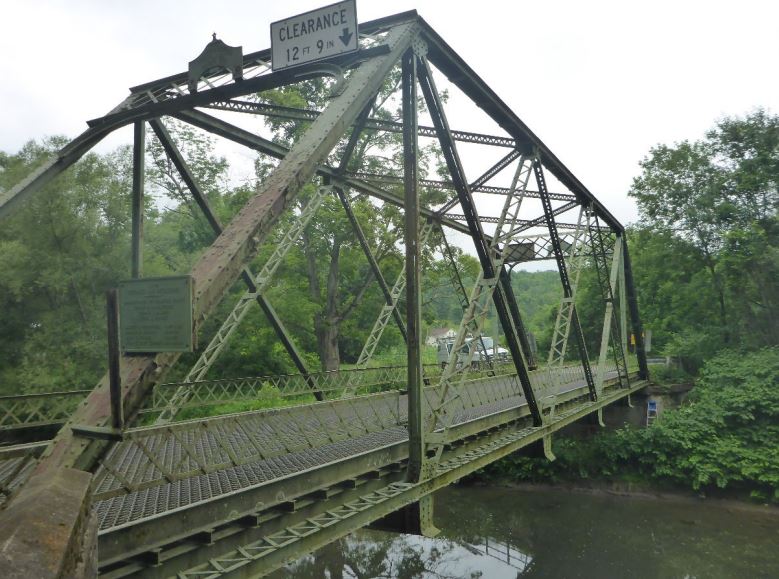This article was originally published by the Pennsylvania State Historic Preservation Office.
Pennsylvania has a long and important history related to metal truss design, fabrication and erection. PennDOT’s SPIKE funding may help with their preservation as part of the commonwealth’s transportation infrastructure.
Pennsylvania is full of historic metal truss bridges
Pennsylvania’s varied terrain necessitated the building of many thousands of bridges. Additionally, the era of metal truss experimentation heightened during the second half of the 19th century and early part of the 20th century. These two things together resulted in the erection of a wide variety of metal truss bridge types and designs across the commonwealth.
 Cons Road Bridge over Towanda Creek in Bradford County.
Cons Road Bridge over Towanda Creek in Bradford County.
The demands of modern vehicular traffic, in combination with the age of these structures and other factors, however, has resulted in the loss of much of the historic metal truss bridge (HMTB) population.
PennDOT’s Efforts to Preserve HMTBs
In recognition of this, PennDOT, in conjunction with the PA SHPO, developed a management plan that seeks to find ways to preserve at least some of the remaining population of historic metal truss bridges.
Many of these bridges are owned by counties and municipalities, rather than PennDOT, which necessitated a broad outreach effort.
In 2017, PennDOT and SHPO staff met with the bridge owners, planning partners (Metropolitan Planning Organizations [MPOs] and Rural Planning Organizations [RPOs]), and interested parties to discuss those historic metal truss bridges that weren’t already part of a planned project.
The purpose of the meetings was to make owners aware of the historical importance of these bridges and to collect more information on their current and future use. The primary goal was to determine, at least preliminarily, the needs of these crossings and whether each historic bridge is capable, or could be capable through rehabilitation and/or on-going maintenance, of meeting those needs into the future.
One of the primary messages relayed by local owners and the MPOs and RPOs, was the difficulty of advancing the more rurally-located bridges (i.e. those with very low traffic volumes) onto the
Statewide Transportation Improvement Program (STIP), by which the bridges could receive federal and/or state funds for rehabilitation.
It was clear that a dedicated program for the preservation of locally-owned historic metal truss bridges was needed.
Potential Funding Option
PennDOT is pleased to communicate that PennDOT Deputy Secretary Larry Shifflet, as part of the 2021 State Transportation Improvement Program Update, has recommended a program to benefit county and municipally owned historic metal truss bridges beginning in federal fiscal year 2023.
The proposed program will consist of $1 million dollars in 2023, $1 million dollars in 2024, and $2 million dollars each year for the remainder of the twelve-year program (8 years).
The funds will be coming from Federal “STP” funding (SPIKE Funds). The program will utilize toll credits and therefore not require a local match. Bridges to benefit from this program will be selected by a committee of PennDOT, FHWA and PA SHPO representatives.
Identifying Eligible Projects
The program will utilize the following criteria in selecting bridges for the rehabilitation program:
- Bridges evaluated as “exceptional” or “high” historic preservation priority. These are the rarest and/or most unique of the remaining population of historic metal truss bridges.
- Bridges not already funded on the STIP.
- Bridges whose owners have committed to maintain the bridge and have expressed an interest in the historic preservation value of the bridge. This commitment came verbally in the management plan, but will be more formalized as a “maintenance plan” as part of rehabilitation planning.
- The public interest in, and the public visibility of, the bridge. Emphasis will be placed on bridges that are highly visible and/or have strong public support for their preservation.
- Cost will be factored in to the selection. To the degree all other factors are equal, funds will be leveraged to get the “most bang for the buck” in terms of bridges that need less work, in order to preserve as many bridges as possible with these funds.
It is hoped that additional funds can be brought into the program to advance bridges through design prior to 2023 such that the 2023 funds can advance one or more bridges into construction. The emphasis of the program, at least initially, will be on bridges that can be rehabilitated to meet vehicular needs. A separate program is being piloted to support the adaptive use of bridges that cannot meet transportation needs.
Looking for More Information?
More information on this program will be posted to PennDOT’s cultural resource’s website as the details of this program are refined and with the finalization of the STIP in October 2020.
Questions about the program can be addressed to PennDOT’s Cultural Resources Unit Manager, Kara Russell, at krussell@pa.gov.
Interested in learning more about historic metal truss bridges in Pennsylvania? Sign up for the PA Historic Preservation Office's Historic Metal Truss Bridge Newsletter!